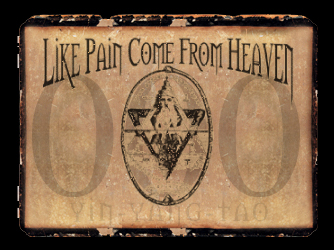
All content & writing by Brad Jaeger © The NACHTKABARETT
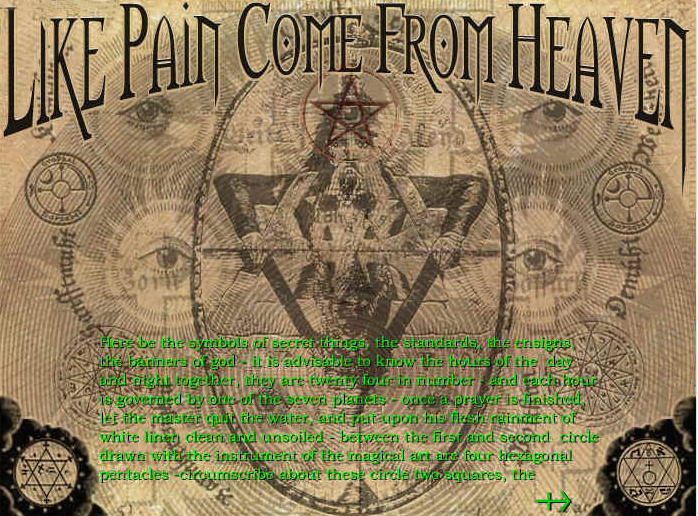 Like Pain Come From Heaven.com hompage
Like Pain Come From Heaven.com hompage*NK NOTE: We are seeking any and all flash animation files or site archives from The Smashing Pumpkins Machina era secret websites. If you've saved any of these yourself or have any original files in your possession which you do not see in this section, please contact if you can help. You will be fully credited for your assistance*

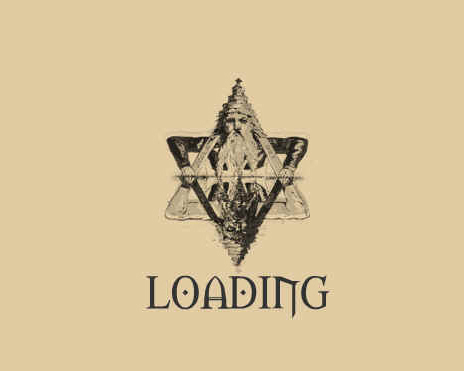
During the Machina era, when it was operational, web users who managed to come across one of the Smashing Pumpkins websites, www.likepaincomefromheaven.com were greeted with the figure below as the initial loading screen.
The figure seen above is none other than Jehovah, albeit depicted in an alchemical light. This is likely due to the fact that this particular image derives from Eliphas Lévi, one of the most notoriously gifted magicians of the past several centuries. Lévi is widely famous for his interpretation of Baphomet and his groundbreaking work Transcendental Magic continues to be a valuable resource to occultists worldwide.
The figure is known as The Great Symbol of Solomon, and is a hand drawn image by Eliphas Lévi, featured within Transcendental Magic.
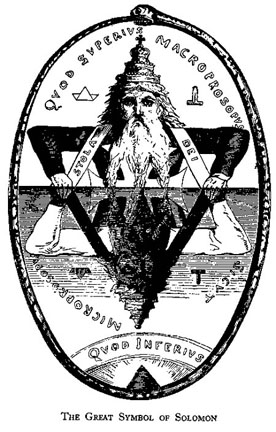 |
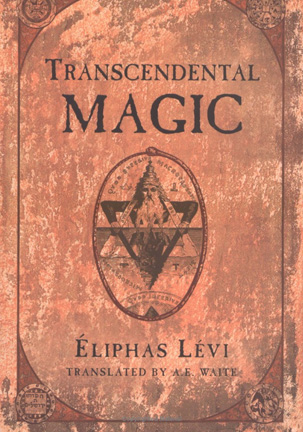 |
| The Great Symbol of Solomon, illustrated on the cover piece of Lévi's 'Transcendental Magic', depicting the Black and White Jehovah, with the Heavens above, Hell below, and the material world caught in the center of his affection. The Ouroboros makes another appearance, reinforcing the concept of infinity, unity and the all encompassing nature of the divine. | |
While some may argue the symbol is unmistakably a Star of David, the symbol, otherwise known as the hexagram, or double triangle, is presented from an alchemical perspective, thus negating the possibility of it being primarily Hebraic in nature. However, the God represented within is Jehovah, so one must acknowledge at least some semblance of Judaic influence.
That being said, the symbol was likely drawn to highlight certain alchemical concepts, the most prominent of which is the principle of "As above, so below", acknowledged by all occultists to be a universal truth. This is evident based on the dichotomist, mirror-like quality to the image, the presentation of a white Jehovah and the presentation of a black Jehovah.
One can note the upper arms being black, with the mirrored reflection being white. Similarly, one triangle is black while the other is white, as are the symbols to both sides of Jehovah's head. The top of the diagram depicts Heaven, the bottom, Hell. Earth resides in betwixt both, the only material plane which humanity experiences in their lifetime.
God is not presented in the Judean Christian sense of being purely benevolent either. Rather, Jehovah is interpreted as most Gnostics, Hermeticists, Occultists and Kabbalists interpreted him, which is, as an all encompassing force found within everything animate and inanimate, good and evil, material and spiritual, permeating through all realms, not just what mankind would interpret as "benevolent".
As such, the mirror image of the head appears to be more malevolent, and perhaps even a little demonic. This exists to further the teaching "as above, so below". One is all, and all is one, with humanity being just a microcosm of the divinity of the great macrocosm. White and black Jehovah resides as the King of mercy and vengeance, forgiveness and damnation.


One of the many websites which appeared during the creation and release of Machina: The Machines of God was a site located at www.likepaincomefromheaven.com. At the time, Like Pain Come From Heaven was a website heavily laden with images of alchemical seals, hermetic principles, instructions for drawing of the grand pentacle and other occult concepts. The Nachtkabarett will continue to uncover as many symbols as possible with subsequent updates.
To proceed further, a username and password were required. The username was revealed to be "aeon_of_maat" and its password was "balance".
In order to understand The Aeon of Ma'at and its relation to balance, it is essential to have a general understanding of the Aeons themselves, both in the Kabbalistic & Gnostic sense, as well as the more literal interpretation of an Aeon being an "age" or period of time, as both are applicable in this scenario. It is also vital to understand the four Aeons which were created by Aleister Crowley, and which served as the password to Like Pain Come From Heaven.
The Aeon is a concept which can be found in the structural makeup of many paths of magick, gnosis, and divinity. The concept of the Aeon is especially prevalent among the Gnostics, Kabbalists and mystics of numerous religions and spiritual branches.
According to many Gnostic and Kabbalists writings, Aeons were regarded as the various emanations of God, often equated to the Judeo-Christian concept of angels due to their similarity in being messengers of pure light, serving a higher power. Some Gnostic Angels were coincidentally also Aeons themselves.
Thirty-six Aeons are accounted for, mirroring the Kabalistic Tree of Life and its ten Sephiroth with twenty-two paths. These Aeons characterize everything from love, life, union, pleasure, hope, intelligence, and much more. Two of the Aeons most commonly referred to were that of Christ, and Sophia (Wisdom). The Aeons represented manifestations and characterizations of idealistic traits.
The grand occultist, Aleister Crowley, well versed in a multitude of esoteric traditions, would undoubtedly have examined the Aeons of Kabalistic origin, which likely served as some form of inspiration for the four Aeons which he would invent and write of in The Book of the Law, and otherwise. Those four Aeons being: Isis, Osiris, Horus & Ma'at.

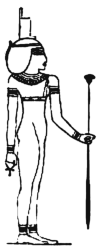 Isis, Queen of the Throne, Mother to Horus, and Wife/Sister to Osiris
Isis, Queen of the Throne, Mother to Horus, and Wife/Sister to OsirisThe first Aeon which Aleister Crowley described was that of Isis, the Egyptian archetypal mother goddess, initially formed by her nurturing and maternal characteristics. This Aeon was described in the 1938, O.T.O edition of The Book of the Law as "Isis, the mother, when the universe was conceived as simple nourishment drawn directly from her; this period is marked by matriarchal government".
Driven by druid and pagan worship of the veneration of Mother Earth, it was described in Equinox of the Gods as "simple, quiet, easy, and pleasant". This Aeon of matriarchal societal construction was celebrated by the pagans, described by the historians, mythologized by bards and poets alike, and examined by the philosophers. It was supplanted circa 500 B.C. by the Aeon of Osiris.

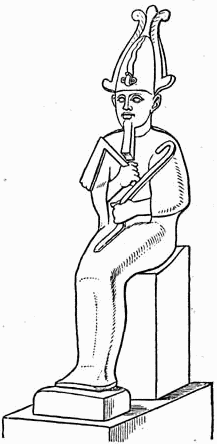 Osiris, the dying God
Osiris, the dying GodThe second Aeon described by Aleister Crowley was the Aeon of Osiris, which supplanted the Aeon of Isis around 500 B.C. Equinox of the Gods notes, "The second is of suffering and death: the spiritual strives to ignore the material .Christianity and all cognate religions worship death, glorify suffering, deify corpses."
The Aeon of Osiris was marked by numerous patriarchical figures who ruled under the guise of authority, succession, and divine right. More importantly, Osiris was an Aeon which made heavy use of the Medieval and Classical notions of the Dying God; a figure typically (though not always) born of a virgin, slain, and subsequently resurrected. Such figures are plentiful in the mythology of cultures all around the world and include: Adonis, Mithras, Odin, Baldur, and Osiris â?? to name but a few â?? all of whom share the principle aspect of the resurrection. These divine figures represented self-sacrifice through the submission to an almighty God, thus heralding in a paternal society built upon obedience and a fear which was instilled into the heart of mankind. Fear gave way to a subservient nature to figures of authority, particularly those within the church.
Crowley would write that "...men worshiped Man, thinking him subject to Death, and his victory dependent upon Resurrection. Even so conceived they of the Sun as slain and reborn with every day, and every year."
The Aeon of Osiris existed from the dissolution of the Aeon of Isis until 1904 when Aleister Crowley proclaimed the dawning of a new Aeon within his writing of The Book of the Law.

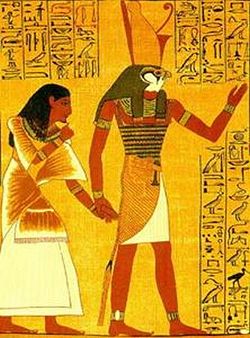 Horus, the high God of the Sun
Horus, the high God of the SunWith the publishing of The Book of the Law in 1904, Crowley ushered in a new Aeon, the Aeon of Horus.
The crowned and conquering child, who dieth not, nor is reborn, but goeth radiant ever upon His Way. Even so goeth the Sun: for as it is now known that night is but the shadow of the Earth, so Death is but the shadow of the Body, that veileth his Light from its bearer.Aleister Crowley, Heart of the Master
The Aeon of Horus is here: and its first flower may well be this: that, freed of the obsession of the doom of the Ego in Death, and of the limitation of the Mind by Reason, the best men again set out with eager eyes upon the Path of the Wise, the mountain track of the goat, and then the untrodden Ridge, that leads to the ice-gleaming pinnacles of Mastery!Aleister Crowley, Little Essays Towards Truth, "Mastery"
The age of Horus can best be described as a period of time in which the individual develops an interest in the world of spirituality, and theology. The individual is marked by a devotion to the principles of Thelema and Agape (Will and Love, respectively), in which the most prominent goal is that of enlightenment, growth, and manifestation of one's True Will, ultimately resulting in self-realization and self-actualization.

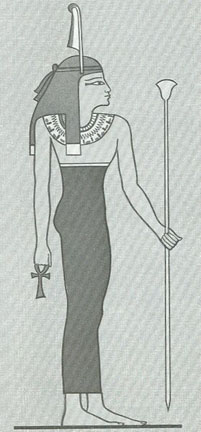 Ma'at, the universal balance, carrying the trademark double wand/scepter/staff
Ma'at, the universal balance, carrying the trademark double wand/scepter/staff Crowley also predicted the rise of a new Aeon in his writings. In his 1920 Extenuation of the Book of the Law (also published as the "New Comment" in Israel Regardie's edition of The Law is for All), he writes of a fourth Aeon:
Hrumachis is the Dawning Sun; he therefore symbolizes any new course of events. The "double-wanded one" is "Thmaist of dual form as Thmais and Thmait," from whom the Greeks derived their Themis, goddess of Justice. The student may refer to The Equinox, Vol. I., No. 2, pp. 244-261. Thmaist is the Hegemon, who bears a mitre-headed scepter, like Joshua in the Royal Arch degree of Freemasonry. He is the third officer in rank in the neophyte ritual of the G\D\ following Horus as Horus follows Osiris. He can then assume the "throne and place" of the Ruler of the Temple when the "Equinox of Horus" comes to an end.p. 289
While not explicitly stated, the Egyptian form of the goddess of Justice characterizes the Aeon of Ma'at, and so the O.T.O and other occult organizations regard this heralding of a fourth Aeon to be the Aeon of Ma'at.
While some disagree on when the Aeon is to occur (some predict it came upon the death of Crowley, while others still believe it has yet to come), all are assured of what it will herald in: an unmistakable era of law, morality, truth, beauty, justice and balance. Fitting, as Ma'at itself was the representation of these very same ideals. It is this Aeon and its guiding principles which served as the direct source of the username and password presented on the Like Pain Come From Heaven website.

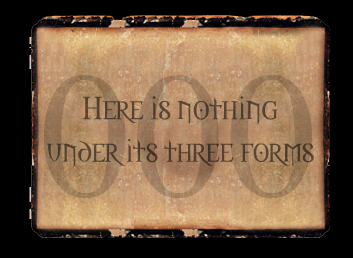 |
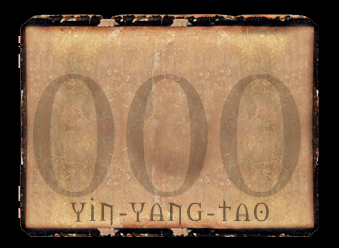 |
Corgan references another work by grand occultist Aleister Crowley, known as Liber XXVII: Liber Trigrammaton. The reference being made is, " Here is Nothing under its three forms. It is not, yet informeth all things" which is contained within LIber XXVII.
The text is primarily focused on our genesis and the creation of the cosmos from a perspective of mutations of the Tao with and within the Yin and the Yang:
Except from Liber XXVII: Liber TrigrammatonAlso there rose up a soul of filth and of weakness, and it corrupted all the rule of the Tao.
Then only was Heaven established to bear sway; for only in the lowest corruption is form manifest.
Also did Heaven manifest in violent light
And in soft light.
Therefore was the end of it sorrow; yet in that sorrow a sixfold star of glory whereby they might see to return unto the stainless Abode; yea, unto the Stainless Abode.
